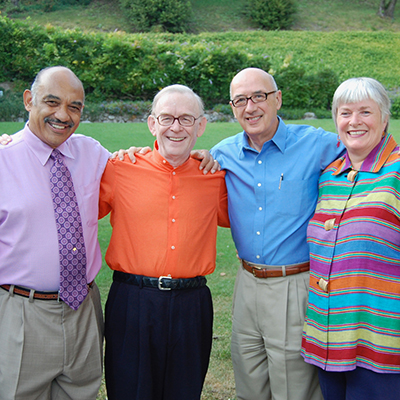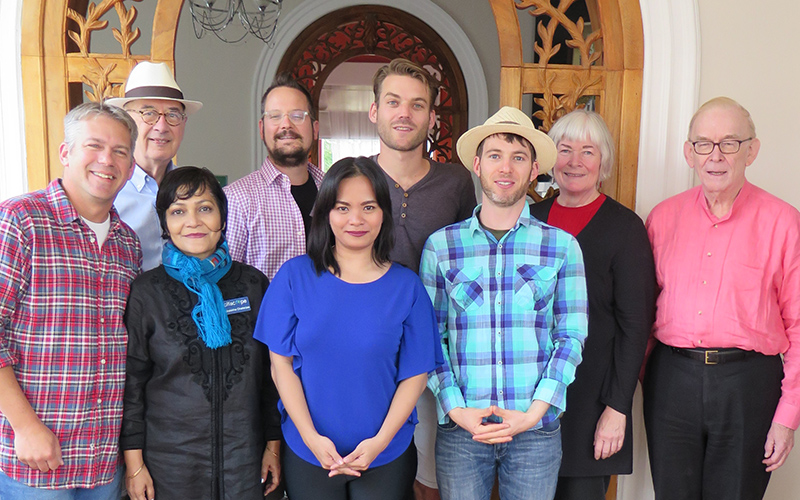— Supporting journalism on city solutions —
About Neal Peirce
 In his long and distinguished journalism career, Neal was known for traveling across the U.S. to interview local leaders, grassroots activists, and other urban changemakers. In his nationally syndicated column, he chronicled their ideas for building affordable housing, boosting transit, improving education, and all the ways they aimed to make cities and metro regions better places for all their people.
In his long and distinguished journalism career, Neal was known for traveling across the U.S. to interview local leaders, grassroots activists, and other urban changemakers. In his nationally syndicated column, he chronicled their ideas for building affordable housing, boosting transit, improving education, and all the ways they aimed to make cities and metro regions better places for all their people.
He was the only journalist covering local government and regions from a national perspective. He said his goal was “to cross-fertilize ideas” and “to show the amazing new forces at work at the local level.”
The following are excerpts of a remembrance by Neal Peirce Foundation Treasurer, William Fulton, director of the Kinder Institute for Urban Research.
Neal wrote the first — and so far, only — nationally syndicated newspaper column about cities and states. He wrote numerous books about them and took the lead in producing 25 reports in the 1980s and ‘90s on America’s metropolitan regions and how they could work better. He traveled around the country for decades, talking to mayors, governors and economic development experts about the latest trends in a very pragmatic what-works kind of way.
THE CONVERSATION STARTED WITH NEAL PEIRCE
More or less single-handedly, he started the discussion about urbanism in the United States. This conversation would not be going on — at least not in the as robust a way — if Neal hadn’t started it.
HOW HE DID IT IS A REMARKABLE STORY
In the ‘60s, Neal had been a straight-up political reporter — he wrote a book in 1968 calling for the end of the Electoral College — but after the urban riots of the late ‘60s he did an amazing about-face that no normal inside-the-Beltway journalist would even dream of: He turned his attention to cities and states. He began traveling the country and writing about what was going on at the local and state level in a way that no one else was doing — primarily through his syndicated column with the Washington Post Writers Group.
MEETING MY MENTOR
I first encountered Neal in the winter of 1980, as he stepped out of the elevator at 1730 M Street Northwest in Washington D.C., and into the newsroom of National Journal, a D.C. insider’s magazine that he had helped found and where I was working as an intern. He had flaming red hair and he was wearing his trademark oversized glasses and a typical optimistic smile. He was also wearing a bicycle helmet and pushing his bike out of the elevator.
Urban bicycling is so common these days that it’s hard to describe how quirky this seemed at the time. Nobody rode bikes in those days, least of all across a large, crowded city to get to work. Yet this guy standing in front of me in a bicycle helmet was probably the most important person of the last half-century in moving forward a conversation in the United States about urbanism and how cities can help make people’s lives better.
When I first met him, Neal and his associate Jerry Hagstrom were writing their landmark book, The Book of America: Inside Fifty States Today, an update of John Gunther’s classic Inside USA — essentially a Cook’s Tour of states and communities across the country. I was so in awe of what Neal was doing that I barely dared to speak to him.
I tried to compete with Neal. It wasn’t hard in those days to get one-off op-eds published in major newspapers on urban topics, but it proved impossible to make a deal with a news syndicate that would distribute a regular column. I was told that there was only one Neal Peirce (which was right) and that there “wasn’t another generation” in writing about cities (which, in the age of the internet, couldn’t have turned out to be more wrong). So, I settled into a career of writing about cities for specialized publications.
But by this time Neal was on to his next big thing — the so-called Peirce Reports. Teaming up with longtime collaborator Curtis Johnson and others, Neal roamed the country, writing about metropolitan regions and the steps they might take to become stronger, more prosperous and more equitable. The Peirce Reports are often credited with stimulating regional action on economic development, transit and other policy issues in cities ranging from Dallas to Charlotte to Seattle.

From left: Dr. Lenneal Henderson, Neal Peirce, Curtis Johnson, Farley Peters, the team behind the book “Century of the City.”
Over time, Neal wrote about 25 such reports and in the process, he foreshadowed today’s model of nonprofit journalism. He would make connections with local political leaders he knew, who would help persuade a local foundation to pay for Peirce’s team to do a big report, which would then be published in the local newspaper.
THERE’S A NEED FOR METRO-AREA LEADERS TO WORK TOGETHER
Neal became so convinced that metropolitan regions were the most powerful players in the future of cities and states that in the 1990s he wrote a book about the topic called Citistates, in which he argued that America would be competitive in the 21st Century only if all the leaders in the country’s metropolitan regions worked together for shared prosperity.
As a result of all this activity, in the mid-‘90s, Neal and Curt created the Citistates Group, which served as a business hub, speakers’ bureau and watering hole for the crowd of people Neal had gathered around him over the years. Many of them were regional economic development experts he had run across in his travels. These were the folks who understood that whether you lived in a city or a suburb or a rural area, it was the regional economy that made things go.
I became a part of this group and — especially as an elected official in a mid-sized city in California — benefited greatly from the expertise on urban and regional issues that gathered around Neal. We met each year for a kind of free-flowing seminar on cities — sometimes near Neal’s summer home in New Hampshire and sometimes in various cities around the country.
CREATING AN ONLINE SITE FOR CITY NEWS
Remarkably, as Neal got older, he did not slow down but instead got more interested in cities around the world, outside of the United States. He continued to write his column until the age of 81. At 76, he published a forward-looking book sponsored by the Rockefeller Foundation laying out the challenges cities face in the 21st Century.
At 82, he founded Citiscope, a nonprofit web-based news site reporting on cities around the world that was later absorbed by the Thomson Reuters Foundation.

The Citiscope team
Almost every day, when I read something online about the role of cities, local governments, urban development and a sense of place, I think of Neal. He was the godfather of that whole conversation. But what must have been heartbreaking to him was the fact that the regional conversation — the one he cared about the most — has withered away, largely a victim of our partisan times.
FIRST TO COVER THE ‘LABORATORIES OF DEMOCRACY’
Neal’s heyday in the 1980s was an unusual time for cities and states. Under the Reagan Administration, the federal government was shedding many traditional roles. A remarkable group of moderate governors on both sides of the aisle picked up the baton: Tom Kean in New Jersey, Bruce Babbitt in Arizona, Dick Thornburgh in Pennsylvania, even Bill Clinton in Arkansas. They saw the states as “laboratories of democracy,” in the words of Supreme Court Justice Louis Brandeis, and experimented with new policies.
Often, they worked together with moderate mayors — Henry Cisneros in San Antonio, Charles Royer in Seattle, Bill Hudnut (Neal’s college classmate) in Indianapolis — to promote the idea that cities and states could work together to nurture prosperity at the regional level.
As Keith Schneider — another longtime collaborator of Neal’s — wrote in his New York Times obituary of Neal: “He paid particular attention to the alliances among elected leaders, nonprofit groups, neighborhood organizations and business executives. Such groups, he reported, formed a hive of ideas that generated unorthodox strategies to enhance local quality of life.”
Nobody but Neal was writing about this stuff back in the ‘80s.

Neal and his wife, Barbara Peirce
AN UNSTOPPABLE AND INFECTIOUS OPTIMISM
Neal never lost his optimism. This optimism spills over into today’s conversations about cities because — despite concerns about gentrification and equity — most people engaged in the urban realm today have a similar optimistic approach. You can see it in Richard Florida’s infectious good nature about cities.
Even the perpetually grumpy Joel Kotkin has never given up hope that cities can be vehicles for upward mobility.
Most of this optimism comes, in one way or another, from Neal’s sunny approach to his work and his faith in cities and regions about their role in helping people improve their quality of life. It’s an optimism we should all carry forward in his memory as we work every day to make cities — and regions — better places to live and work.
Below you will find links to obituaries and remembrances for Neal Peirce following his passing in December 2019.
Neal Peirce, urban affairs columnist who championed inclusive cities, dies at 87
WASHINGTON POST
Neal R. Peirce, Who Put Spotlight on Urban Innovation, Dies at 87
NEW YORK TIMES
An urban visionary who saw what Charlotte might become
CHARLOTTE OBSERVER
Neal R. Peirce-The Man Who Championed-and Helped Save-the American City
COMMON EDGE
Dick Fleming: Journalist and civic visionary Neal Peirce left lasting impacts in St. Louis
ST. LOUIS POST-DISPATCH
Neal Peirce shaped a vision of the Research Triangle
RALEIGH NEWS & OBSERVER
Neal Peirce, chronicler of cities and regions
CNU JOURNAL
Penn IUR Mourns the Loss but Celebrates the Legacy of Neal Peirce
PENN INSTITUTE FOR URBAN RESEARCH
Do you have a special memory of knowing or working with Neal Peirce? Email us at info@nealpeircefoundation.org to discuss adding your remembrance here.
